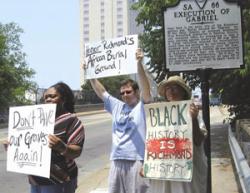by Ana Edwards, Defenders for Freedom, Justice & Equality
 It was a chance encounter that just may have saved Richmond’s oldest Black cemetery.
It was a chance encounter that just may have saved Richmond’s oldest Black cemetery.
Richmonders Shanna Merola and Kenneth Yates were downtown this past May, visiting the parking lot that covers Richmond’s “Burial Ground for Negroes.” The 1.6-acre site lies just north of East Broad Street, between the entrance to I-95 and the CSX railroad tracks.
Merola is a fine art photographer who had included photos of the parking lot in a collection of photographs displayed at the Valentine Richmond History Center, where she is a guest curator. The exhibit was of Black historical sites in Richmond that had been paved over or forgotten. Yates is a sound experimenter with the Hz Collective.
When the two saw some people with clipboards walking around the area, they became curious and asked what was going on.
The people checking out the site said they were “planners” with Virginia Commonwealth University.
They said they were surveying the site in preparation for VCU’s “upgrading” of the parking lot.
The university’s plans have been known for some time. Matthew Freeman, a member of the Gabriel House collective on the city’s Northside, alerted the Defenders last year that information about the plans had been posted on VCU’s Web site.
What wasn’t known was that VCU had since repurchased the parking lot site (it owned it once before, but had sold it to a Cincinnati real estate outfit) and was planning to start the “upgrade” in June.
Alarmed, Merola and Yates called for a protest near the Burial Ground, under the Gabriel Marker on East Broad. (The Defenders led the effort in 2004 to erect the state highway marker near the Burial Ground, where the great slave rebellion leader Gabriel was executed on Oct. 10, 1800.)
The noontime protest, on Monday, June 2, was small, maybe a dozen people. Merola and Yates were joined by Matthew Freeman, Jackson Ward businessman Dawoud Shakur, members of the Defenders, the Sacred Ground Historical Reclamation Project and a few others.
But the action was effective. It received broad media coverage, moving several public officials and representatives of nonprofit organizations to speak out against repaving the site. These included Dwight Jones, chair of the Virginia General Assembly Legislative Black Caucus; William Pantele, president of Richmond City Council; Delores McQuinn, Council Vice President and chair of the city’s Slave Trail Commission; Robin Poulton, president of Virginia Friends of Mali; representatives of the preservationist group ACORN; and more.
Most of these made their statements opposing VCU’s plans during a June 3 outdoor program marking the start of the second phase of archaeological work being conducted on the site of the former Lumpkin’s Jail, an equally historically significant site a few blocks south of Broad Street not far from the Burial Ground.
Several of those speaking out against the “upgrading” plans called for a meeting with VCU President Eugene Trani in order to convey their concerns.
The following day, Delegate Jones, Councilwoman McQuinn and Council President Pantele met with VCU representatives and Kathleen Kilpatrick, director of the Virginia State Department of Historic Resources (DHR) to discuss the issue.
As a result of this meeting, VCU and the Slave Trail Commission on June 6 issued a joint statement agreeing that work on the parking lot would be “suspended” while an investigation is conducted to determine exactly where the Burial Ground lies.
According to Councilwoman McQuinn, the first stage of this investigation will be to review the research conducted by local author and historian Elizabeth Cann Kambourian that confirms the existence of the Burial Ground.
Kambourian’s work has been used many times before — often without credit — since she first presented it in the mid-’90s.
While researching a book she was writing, Kambourian came across an old city map drawn in 1780 and then revised in 1809 by the original cartographer, Richard Young.
There, on the site now occupied by the VCU parking lot, is a plot labeled “Burial Ground for Negroes.”
In the center of the site is a symbol for the city gallows.
Her research was accepted by the DHR to support the Defenders’ application for the establishment of the Gabriel Marker. (Kamborian served on that project’s advisory committee, along with Dr. Douglas R. Egerton, author of “Gabriel’s Rebellion,” and Dr. Haskell S. Bingham, a great, great, great, great-grandson of Gabriel and the family’s oral historian.)
The next step, according to Councilwoman McQuinn, will be to work with the James River Archaeological Society or other experts in the field to determine the best location for an initial survey.
Finally, McQuinn says, there will be a Town Hall-type meeting at which a report and recommendations will be presented.
A key issue at stake is the size of the area to be preserved. The actual lot that includes the parking lot measures 1.6 acres. The city map that Kambourian discovered seems to indicate that the entire lot was the site of the Burial Ground.
After trying unsuccessfully to interest city officials in her findings, Kambourian presented her research at a public meeting held at the Black History Museum and Cultural Center of Virginia in Richmond’s Jackson Ward. One of those present was Janine Bell, founder and artistic director of the Elegba Folklore Society, who is also a member of the Slave Trail Commission. Bell invited Kambourian to make a presentation to the commission, and also decided to incorporate the site in Elegba’s annual Night Walk Along the Trail of Enslaved Africans.
As a result, the site already ranks as an important gathering place for large numbers of people meeting to remember and honor Richmond’s Black ancestors.
Reclaiming the Burial Ground also was vigorously taken up by former City Councilman Sa’ad El-Amin, who founded the Slave Trail Commission in 1998.
It should not be forgotten that it was public outcry that stimulated the current apparent progress in the reclamation of this important site. Public participation and an open community-driven process will serve a project like this best.
The Slave Trail Commission is scheduled to meet again on July 10 at 4 p.m. in the East District Center, 725 N. 25th Street in Richmond’s Church Hill neighborhood. Aside from continuing to send letters and e-mails to VCU President Trani, this meeting provides the next opportunity for input.
Significantly, outgoing Richmond Mayor L. Douglas Wilder – a well-paid VCU employee and promoter of the U.S. National Slavery Museum based in Fredericksburg, Va. – has refused to comment on this issue.



